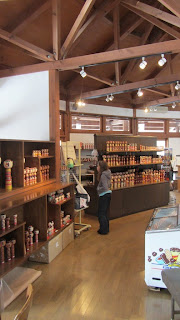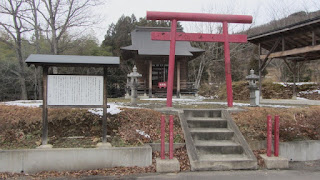Continuing on our big kokeshi adventure from last December, after leaving the Sakunami and Akiu area we headed south on the Tohoku Expressway for about 30 minutes until getting off at the exit for Shiroishi City (白石市) in southernmost Miyagi Prefecture, right on the border with Fukushima. Destination: the Yajiro Kokeshi Village 弥次郎こけし村 in the hills west of Shiroishi. We were having a cold but pleasant winter day with good views of the mountains, and we even saw a flock of Russian swans on the side of the road. Thanks to our iPad's Google map and its directions we had no problem finding our way through the generally sign-less countryside, at least to a point. Word to my fellow foreigners -- if you come here you will get lost without a proper map and directions!
 |
| Countryside. |
 |
| Mountains. |
 |
| Swans. |
As we puttered along Naoko and I searched for road signs that would lead us to the Yajiro homeland, and after a while finally spotted one that let us know we were indeed on the right path. At this point we were starting to go up the side of the mountain, and although there was some snow on the side of the road it had been warm enough that most of the ice and snow had melted. That was a good thing since we were snaking up and a down a narrow and precarious mountain road. We finally came to a kokeshi shop with a couple of large kokeshis out front, but it was shut tight and looked like it had seen much better days in the past. Hmmm. We crossed a kokeshi bridge of the sort that all kokeshi towns seem to have, and the Yajiro kokeshis at each end were freshly painted. This confirmed that this was likely a thriving kokeshi community. After that we went through Yajiro (the bus stop sign), a small settlement that was made up of a few closed kokeshi shops. Not a good omen it seemed, but there were more and more signs for various kokeshi workshops, so we were definitely in a kokeshi-dominated area. But where were the kokeshi makers, and where was the Yajiro Kokeshi Village? We continued to drive up the hill with Mt. Zao, home of another kokeshi tradition, right in front of our eyes. At that point it became clear that this general area, connecting Naruko, Sakunami, Akiu, Togatta, Zao, Yamagata, and Yajiro is definitely a kind of kokeshi ground zero. Wow.
 |
| The first shop we encountered was shuttered. |
 |
| Ah, a kokeshi bridge. Always a good sign that kokeshis are nearby. |
 |
| Fresh paint -- another good sign. |
 |
| Another closed kokeshi shop. |
As we drove along admiring Mt. Zao we went around a corner and up a sharp incline, and at the top was the Kokeshi Village. Finally. And, hurray! The Yajiro Kokeshi Mura main building is definitely distinctive, being perfectly circular and resembling a gigantic wooden yurt. There was no entrance fee, so we strolled right in. The inside is very pleasant with exposed wooden beams on the second floor, and an open courtyard in the center. There were some rooms for workshops, a small restaurant of some sort, and a very nice gift shop with lots and lots of (mainly) Yajiro-type kokeshis 弥次郎系こけし and kokeshi souvenirs. There weren't very many people though, guests or workers, so we basically had the place to ourselves. However, rather than do some shopping at this point we heading downstairs and out back to the "village" area; i.e., where the kokeshi makers have their workshops.
 |
| Walking to the main building with Mt. Zao in the background. |
 |
| Yajiro kokeshis for sale. |
 |
| The girls playing with tops. |
 |
| A small display of Yajiro kokeshis on the building's first floor. |
 |
| Mail box. |
 |
| The back side of the main building. Those rocks are pretty large and became a good climbing spot for the girls. |
Below are a few of the kokeshi workshops in a circle behind the main building.
By the way, there was even a Kokeshi Shrine where there is apparently an annual ceremony of some sort for kokeshi makers. That must be pretty interesting to see.
Next blog: A visit with one of the kokeshi makers!





































